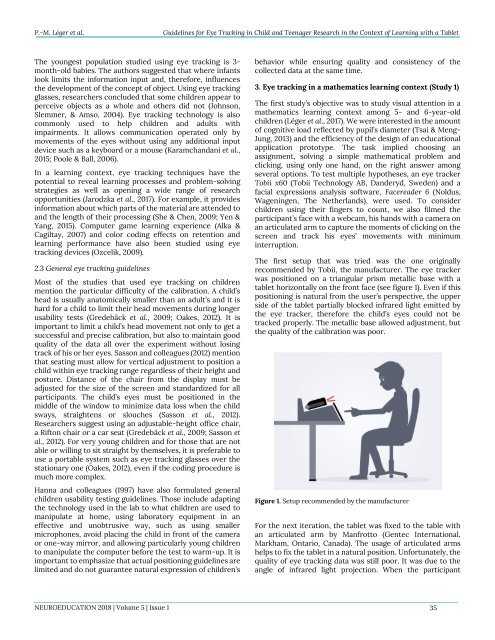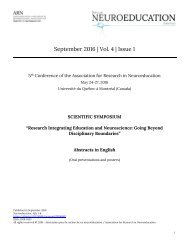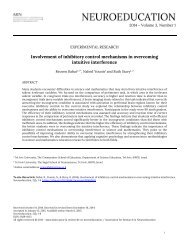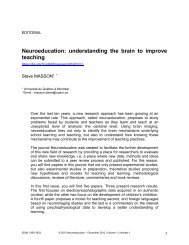Neuroeducation_2018_vol-5_no-1_full
Volume 5, Numéro 1 de la revue scientifique bilingue en libre accès Neuroéducation
Volume 5, Numéro 1 de la revue scientifique bilingue en libre accès Neuroéducation
- No tags were found...
You also want an ePaper? Increase the reach of your titles
YUMPU automatically turns print PDFs into web optimized ePapers that Google loves.
P.-M. Léger et al.<br />
Guidelines for Eye Tracking in Child and Teenager Research in the Context of Learning with a Tablet<br />
The youngest population studied using eye tracking is 3-<br />
month-old babies. The authors suggested that where infants<br />
look limits the information input and, therefore, influences<br />
the development of the concept of object. Using eye tracking<br />
glasses, researchers concluded that some children appear to<br />
perceive objects as a whole and others did <strong>no</strong>t (Johnson,<br />
Slemmer, & Amso, 2004). Eye tracking tech<strong>no</strong>logy is also<br />
commonly used to help children and adults with<br />
impairments. It allows communication operated only by<br />
movements of the eyes without using any additional input<br />
device such as a keyboard or a mouse (Karamchandani et al.,<br />
2015; Poole & Ball, 2006).<br />
In a learning context, eye tracking techniques have the<br />
potential to reveal learning processes and problem-solving<br />
strategies as well as opening a wide range of research<br />
opportunities (Jarodzka et al., 2017). For example, it provides<br />
information about which parts of the material are attended to<br />
and the length of their processing (She & Chen, 2009; Yen &<br />
Yang, 2015). Computer game learning experience (Alka &<br />
Cagiltay, 2007) and color coding effects on retention and<br />
learning performance have also been studied using eye<br />
tracking devices (Ozcelik, 2009).<br />
2.3 General eye tracking guidelines<br />
Most of the studies that used eye tracking on children<br />
mention the particular difficulty of the calibration. A child’s<br />
head is usually anatomically smaller than an adult’s and it is<br />
hard for a child to limit their head movements during longer<br />
usability tests (Gredebäck et al., 2009; Oakes, 2012). It is<br />
important to limit a child’s head movement <strong>no</strong>t only to get a<br />
successful and precise calibration, but also to maintain good<br />
quality of the data all over the experiment without losing<br />
track of his or her eyes. Sasson and colleagues (2012) mention<br />
that seating must allow for vertical adjustment to position a<br />
child within eye tracking range regardless of their height and<br />
posture. Distance of the chair from the display must be<br />
adjusted for the size of the screen and standardized for all<br />
participants. The child’s eyes must be positioned in the<br />
middle of the window to minimize data loss when the child<br />
sways, straightens or slouches (Sasson et al., 2012).<br />
Researchers suggest using an adjustable-height office chair,<br />
a Rifton chair or a car seat (Gredebäck et al., 2009; Sasson et<br />
al., 2012). For very young children and for those that are <strong>no</strong>t<br />
able or willing to sit straight by themselves, it is preferable to<br />
use a portable system such as eye tracking glasses over the<br />
stationary one (Oakes, 2012), even if the coding procedure is<br />
much more complex.<br />
Hanna and colleagues (1997) have also formulated general<br />
children usability testing guidelines. Those include adapting<br />
the tech<strong>no</strong>logy used in the lab to what children are used to<br />
manipulate at home, using laboratory equipment in an<br />
effective and u<strong>no</strong>btrusive way, such as using smaller<br />
microphones, avoid placing the child in front of the camera<br />
or one-way mirror, and allowing particularly young children<br />
to manipulate the computer before the test to warm-up. It is<br />
important to emphasize that actual positioning guidelines are<br />
limited and do <strong>no</strong>t guarantee natural expression of children’s<br />
behavior while ensuring quality and consistency of the<br />
collected data at the same time.<br />
3. Eye tracking in a mathematics learning context (Study 1)<br />
The first study’s objective was to study visual attention in a<br />
mathematics learning context among 5- and 6-year-old<br />
children (Léger et al., 2017). We were interested in the amount<br />
of cognitive load reflected by pupil’s diameter (Tsai & Meng-<br />
Jung, 2013) and the efficiency of the design of an educational<br />
application prototype. The task implied choosing an<br />
assignment, solving a simple mathematical problem and<br />
clicking, using only one hand, on the right answer among<br />
several options. To test multiple hypotheses, an eye tracker<br />
Tobii x60 (Tobii Tech<strong>no</strong>logy AB, Danderyd, Sweden) and a<br />
facial expressions analysis software, Facereader 6 (Noldus,<br />
Wageningen, The Netherlands), were used. To consider<br />
children using their fingers to count, we also filmed the<br />
participant’s face with a webcam, his hands with a camera on<br />
an articulated arm to capture the moments of clicking on the<br />
screen and track his eyes’ movements with minimum<br />
interruption.<br />
The first setup that was tried was the one originally<br />
recommended by Tobii, the manufacturer. The eye tracker<br />
was positioned on a triangular prism metallic base with a<br />
tablet horizontally on the front face (see figure 1). Even if this<br />
positioning is natural from the user’s perspective, the upper<br />
side of the tablet partially blocked infrared light emitted by<br />
the eye tracker, therefore the child’s eyes could <strong>no</strong>t be<br />
tracked properly. The metallic base allowed adjustment, but<br />
the quality of the calibration was poor.<br />
Figure 1. Setup recommended by the manufacturer<br />
For the next iteration, the tablet was fixed to the table with<br />
an articulated arm by Manfrotto (Gentec International,<br />
Markham, Ontario, Canada). The usage of articulated arms<br />
helps to fix the tablet in a natural position. Unfortunately, the<br />
quality of eye tracking data was still poor. It was due to the<br />
angle of infrared light projection. When the participant<br />
NEUROEDUCATION <strong>2018</strong> | Volume 5 | Issue 1 35








